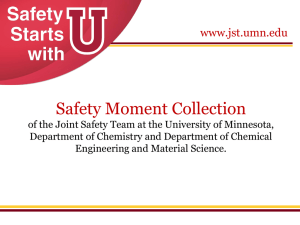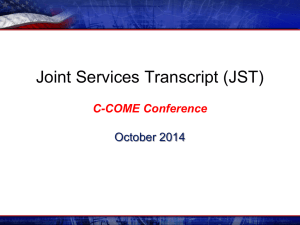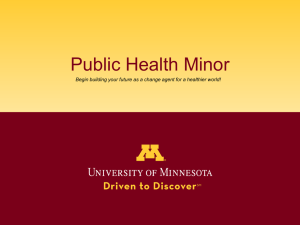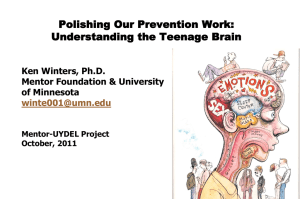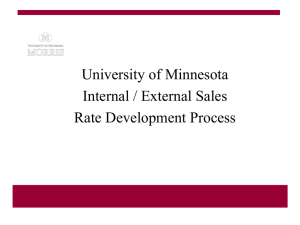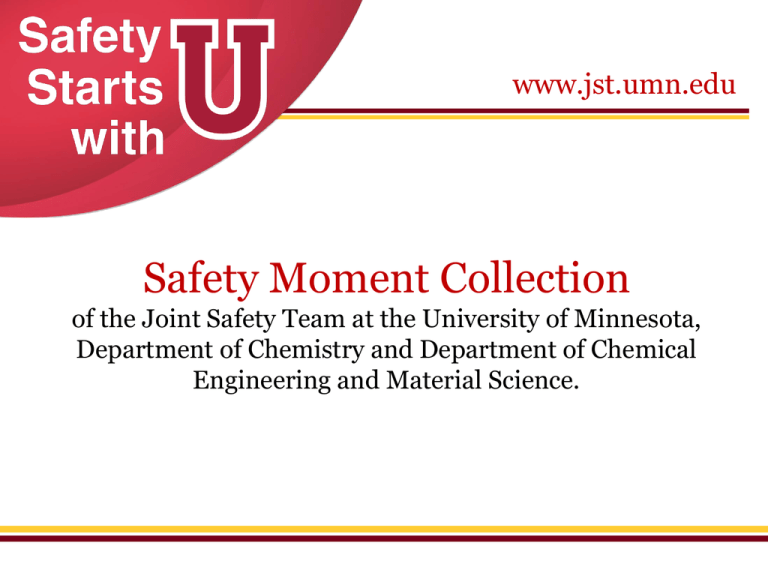
www.jst.umn.edu
Safety Moment Collection
of the Joint Safety Team at the University of Minnesota,
Department of Chemistry and Department of Chemical
Engineering and Material Science.
www.jst.umn.edu
Use these safety
moments as you see fit.
Feel free to adapt a safety moment to meet the specific
needs and time constraints of an audience or occasion;
this may mean using only a portion of the prepared
slides for a topic or including additional
resources for an in-depth discussion.
www.jst.umn.edu
Have a safety moment?
Contribute it to this collection.
Send safety moments to jst@umn.edu
with Safety Moment <topic> in the subject line.
Please put content in the provided template
and cite reliable, credited sources.
Thank you!
Safe Working Habits
www.jst.umn.edu
www.jst.umn.edu
Standard Operating Procedures
Why are they needed?
Where can find examples?
What is an SOP?
• SOPs are documented instructions used to standardize a
method and communicate hazards
• Write SOPs for procedures, pieces of equipment, and
specific chemicals (or chemical classes).
• SOPs contain:
1
• Procedure
2
• Hazards
3
• Control
4
• Training Documentation
www.jst.umn.edu
UMN, DEHS. Chemical SOP Common Questions
6
Why do we need SOPs?
• Consistency in training
• Safety standards
Satisfy requirements
•
OSHA, lab-specific
training
– Communicate hazards, protect people, equipment, and
• Valuable skill for
environment
• Liability
–
employment
www.jst.umn.edu
UMN, DEHS. Chemical SOP Common Questions
Los Angeles Times. http://articles.latimes.com/2013/apr/26/local/la-me-ucla-prof20130426
Where can I find SOPs?
• In chemistry, an SOP binder is located in Smith 139.
– Not publicly posted on the web for chemical security
– Can be viewed by anyone in the department
• Sharing SOPs is okay
– Ask the PI and LSO for permission to adapt their SOP
• Resources
See DEHS handout “Resources for writing Chemical SOPs Fact Sheet”
–
–
–
–
Prudent Practices, LCSS http://www.nap.edu/openbook.php?record_id=4911&page=235
UC Center for Lab Safety https://cls.ucla.edu/resources/sop-library
UCI Hazardous Procedures SOPs http://www.ehs.uci.edu/programs/sop_library/
Chem Depart Chemical Hygiene Plan
http://www.chem.umn.edu/services/safety/ChemHygPlan.html
www.jst.umn.edu
UMN, DEHS. Resources for writing chemical SOPs fact sheet
8
www.jst.umn.edu
Before Working in the Lab
Things to know before starting to work
in a lab
Before Working in the Lab
Be able to locate:
• Emergency exits
• Eyewash and shower
• Fire extinguisher
• Fire alarm
• Chemical spill kit
• First aid kit
• Emergency telephone
numbers
www.jst.umn.edu
Know:
• Hazards present
• Required PPE
• Required Training
www.jst.umn.edu
Limiting Chemical Exposure
Sign and Symptoms
Reducing Exposure
Chemical Exposure
Factors
Exposure Sites
Topical/
Absorption
(skin and eyes)
Ingestion
– Toxicity
Inhalation
Injection
• extent to which a
substance is
poisonous
– Dosage
• amount of
chemical
exposure
– Duration
• amount of time
exposed to
chemical (acute
vs. chronic)
www.jst.umn.edu
Fox, Stephen; Wilson, James. “Signs and symptoms of chemical exposure” Presentation.
http://www.maine.gov/tools/whatsnew/attach.php?id=241098&an=1
Chemical Exposure:
Signs and Symptoms
Irritation and itching
Skin
• Burning rashes, hives, redness
Respiratory Irritation and inflammation, Cough
• Burning, sore, congested, painful sinuses/throat, lungs
Pain, difficulty with normal tasks
CNS
• Headache/ migraine, dizziness, lightheaded, difficulty concentrating,
weakness, impaired balance, numbness
Burning, irritated
Eyes
• Red eyes, dilated pupils
Nausea, vomiting, diarrhea, pain
GI
• Irritation/burning in stomach or esophagus
www.jst.umn.edu
Fox, Stephen; Wilson, James. “Signs and symptoms of chemical exposure” Presentation.
http://www.maine.gov/tools/whatsnew/attach.php?id=241098&an=1
13
Reducing Chemical Exposure
Strategies to Limit Exposure:
• Substitute a less hazardous chemical when possible
• PPE (gloves, eye protection, lab coats)
• Work in fume hoods or glovebox
• Don’t eat, drink, or chew gum in the lab
– Don’t store food or beverage containers near chemicals
• Be careful when handling needles
• Don’t wear gloves/lab coats outside of the lab
• Wash lab clothing separately from personal clothing
“All things are poisons, for there is nothing without poisonous qualities.
It is only the dose which makes a thing poison.”
―Paracelsus, Roman physician and “the father of toxicology”
www.jst.umn.edu
Prudent Practices in the Laboratory: Handling and Management of Chemical Hazards (2011),
Section 2.C.3 and 6.C.2
Board on Chemical Sciences and Technology (BCST)
http://www.nap.edu/openbook.php?record_id=12654&page=18
14
Extra Clothing
Keep a spare change of clothes in office
…just in case you need them.
At a minimum: T-shirt, jeans, socks.
Why?
• You will be more likely remove contaminated clothing
and not wear hazardous waste.
• If you have a major spill that requires a shower, you can
go home in your own clothes.
www.jst.umn.edu
Fox, Stephen; Wilson, James. “Signs and symptoms of chemical exposure” Presentation.
http://www.maine.gov/tools/whatsnew/attach.php?id=241098&an=1
www.jst.umn.edu
Universal Labeling System
Listing Hazards
Universal Labeling System
Purpose:
•
•
•
Comply with regulatory agency
guidelines
Quickly alert emergency responders or
visitors to hazards
Prevent unknown chemicals, especially
with high turnover
DEHS requirements and
prudent practices:
–
–
–
–
Generator name
Date made
Chemical name
Hazards
What information do you
currently place on labels?
Short Term Plan
• Goal: Quick hazard
identification
• Place sticker on any
large container
–
–
–
–
Hood
Fridge
Chemical bin
Cabinets
Types of Containers
Long Term Plan
• Goal: Hazard identification
for every sample
• Use 1-3 letter code for
hazard on every sample not
in use
www.jst.umn.edu
Labeling Solutions
Why?
Example of a near-miss
Why label vials/bottles?
• General awareness within the lab
• Organization for yourself
• Proper waste disposal
www.jst.umn.edu
Recent Near miss
Unlabeled vial containing a
strong acid was poured into
an organic waste bottle
www.jst.umn.edu
Vapors were allowed to dissipate in
the hood prior to recapping the waste
www.jst.umn.edu
Housekeeping
Combating clutter
24
Clutter / Housekeeping
A TIDY LAB IS A SAFER LAB.
www.jst.umn.edu
University of the Sciences in Philedelphia, Laboratory Housekeeping
http://www.usciences.edu/safety/lmanual/LSlabclean.htm
Housekeeping
To prevent accidents:
• Dispose of unneeded and un-useable chemicals.
• Dispose of unneeded equipment, glassware, papers, etc.
• Find a place for all equipment glassware and chemicals,
and put them in their places.
• Remove items blocking safety showers and eye washes.
• Clean dirty dishes.
• Resolve to tidy up your lab every week!
www.jst.umn.edu
Cleaning up the Lab: Housekeeping
http://www.cmu.edu/ehs/newsletters/lab-safety/Cleaning-up-the-Lab.html
Housekeeping
Use hoods for
experiments, not storage.
Keep lab benches free to
avoid chemical spills.
Do not store
chemicals on the floor.
Proper Storage Procedures:
• Store chemicals in approved chemical storage cabinets / refrigerators.
• Dispose of chemicals that have not been used in > 10 years.
• Dispose of chemicals with compromised containers.
• Keep the lab clutter free.
www.jst.umn.edu
Dept. of Chem and Materials Science & Engineering, Univ. of Arizona,
Privy Press: Safety in Lab, Sept. 22, 2005
www.jst.umn.edu
Lab vs. Office
Good habits for keeping chemicals
where they belong
Safety outside the lab
1. Do not bring lab coats or gloves
into the office, hallways, elevators
and other public places.
2. Disinfect tables and chairs in the
office.
3. Do not carry uncovered
food/beverages between the office
and the lab.
4. Do not chew gum in the office
and then go into the lab.
5. Labcoats should be
laundered/changed frequently.
6. Wash hands before leaving the
lab.
www.jst.umn.edu
DEHS Laboratory Safety Plan
www.dehs.umn.edu/Docs/LSP_2012Final.docx
www.jst.umn.edu
Mobile Phones in the Lab
In the laboratory
Phone use in the lab
Phone uses:
• Talk
• Listen to
music
• Check
messages
• Lab timer
• Calculator
• Look up
information
on the
internet
www.jst.umn.edu
Risks: Transferring hazardous chemicals
phone
face
Phone use in the lab
Put the phone in a
plastic bag
– Touch screen works!
– screen is visible
– Device is not in contact
with hazardous chemicals
www.jst.umn.edu
Dangers of using cell phones in lab
Cellular technology allows phones to have roles in data
collection and communication.
But are cell phones safe to have in the lab?
Consider:
1.
2.
3.
Cell phones have been shown to distract and endanger drivers. Can cell
phones distract scientists during critical tasks as well?
Cell phones are known to interfere with electronics. Is it possible that cell
phones can interfere with equipment being operated in the lab?
Cell phones carry 18 times more harmful bacteria than a toilet handle. Is it
hazardous to bring phones with harmful bacteria into lab environments?
www.jst.umn.edu
5 Potential Dangers of Using Cell Phones in the Lab. Sept 2010
http://www.labmanager.com/?articles.view/articleNo/1138/title/5-Potential-Dangers-of-Using-CellPhones-in-the-Lab/
www.jst.umn.edu
Working alone in the Lab
Working Alone in the Lab
Working alone in the lab
+ hazardous chemicals
special, greater potential hazards and risks
The risk of injury is increased and so is the risk of the
seriousness of the injury. Also, the injured person may not
be able to contact help in the event of an accident. These
are very serious problems.
www.jst.umn.edu
Working Alone in the Lab
• If you must work alone :
– Use the buddy system: don’t work without
someone else knowing where you are and
what you are working on.
– Make arrangements to check on each other
periodically.
• Be smart:
• Limit activity to certain hours (where people may be nearby)
• Limit activity with certain materials.
• Establish a system to contact help immediately
• Be familiar with the chemistry (chemicals and equipment)
no new experiments!
www.jst.umn.edu
Prudent Practices in the Laboratory: Handling and Disposal of Chemicals (1995), Section 5.C.10
Commission on Physical Sciences, Mathematics, and Applications (CPSMA)
http://books.nap.edu/catalog.php?record_id=4911
Working Alone in the Lab
Lab-Specific protocols/ consequences for
• Graduate students
• Undergraduate students
www.jst.umn.edu
Prudent Practices in the Laboratory: Handling and Disposal of Chemicals (1995), Section 5.C.10
Commission on Physical Sciences, Mathematics, and Applications (CPSMA)
http://books.nap.edu/catalog.php?record_id=4911
www.jst.umn.edu
Unattended Operations
Safe Overnight Procedure
Risks
• If proper controls in place, overnight reactions no
more hazardous than during the day
• However, risk higher when no one around to
address malfunction or prevent system alteration
www.jst.umn.edu
39
Recommendation
• Hang laminated form on hood sash, near instruments
– Include date, experiment duration, temp/process, hazards, contact info
– Anna Sitek from DEHS working to provide template. Likely similar to:
www.jst.umn.edu
40
Recommendation
• Hang laminated form on hood sash, near instruments
– Include date, experiment duration, temp/process, hazards, contact info
– Anna Sitek from DEHS working to provide template. Likely similar to:
www.jst.umn.edu
41
Recommendation
STOP,
Take 5form
Pre-task
Risk
Assessment:
• Hang
laminated
on hood
sash,
near instruments
– Include1.date,
experiment
hazards, contact info
Stop
and duration,
think temp/process,
through task
2. Identify hazards
3. Implement controls
4. Check that all risks addressed
5. Do task safely
www.jst.umn.edu
42
www.jst.umn.edu
Before Leaving for Vacation
Before Leaving for Vacation
Safety Precautions
• Stop all reactions
• Place products in sealed, LABELED vials and
store properly
• Close the hood
• Make sure hotplates are turned off
• Walk through the lab and make sure all chemical
and waste bottles are capped and in secondary
containment
“Preparing for Holiday Break.” Environmental Health and Safety, Carneigie Melon University.
http://www.cmu.edu/ehs/newsletters/lab-safety/Preparing-Holiday-Break.html
44
Before Leaving for Vacation
To make your return more pleasant:
• Clean your hood and bench
• Do the dishes
• Make sure your lab journal and spectra binder
are up to date
Enjoy your break!
45
www.jst.umn.edu
Pregnancy and
Chemical Research
Identifying exposure,
assessing risk, and mitigating risk
Pregnancy and Chemical Research
Researchers in chemical labs who are
pregnant need to be aware of potential
health hazards to them and their fetus
• Teratogens
• Ionizing radiation
• Infectious diseases
When a worker becomes aware of a
pregnancy, they should:
• Identify potential exposure to
hazards
• Consult resources regarding
those hazards
• Develop risk mitigation
strategies
European Agency for Safety and Health at Work. Directive 2007/30/EC of the European Parliament and of the Council of 20 June 2007
Kling, Jim “Alone in Lab.” Science Career Magazine 7 April 2006
<http://sciencecareers.sciencemag.org/career_magazine/previous_issues/articles/2006_04_07/nodoi.16787403986169116343>
47
Identifying Exposure
• Chemical
– Teratogens
• Biological
– Infectious diseases
• Physical
–
–
–
–
–
Examples of Known Teratogens
Arsenic, Cadmium, Lead, Mercury
Benzene, Toluene, Xylene
Ethylene Oxide, Ethylene Glycol, Vinyl
Chloride
Keep in mind that exposure limits are
often several orders of magnitude lower
for pregnant women due to fetus
sensitivity. Exposure is especially
significant in the first 14 to 60 days of
pregnancy.
Noise
Radiation
Extreme cold/heat
Heavy lifting
Physical fatigue (standing or sitting too long)
University of Minnesota Chemical Hygiene Plan accessed 4 April 2013
http://www.chem.umn.edu/services/safety/tables/tabXVIII.htm
European Agency for Safety and Health at Work. Directive 2007/30/EC of the European Parliament and of
the Council of 20 June 2007
Assessing Risk
• Consult at least 2-3 health sources regarding hazard
– Material safety data sheets (MSDS)
– National Institute for Occupational Safety and Health (NIOSH)
– Occupational Safety and Health Administration (OSHA)
• Understand amount and duration of exposure
– Consider volumes, concentrations
– Exposure testing is available through DEHS
Kling, Jim “Alone in Lab.” Science Career Magazine 7 April 2006
<http://sciencecareers.sciencemag.org/career_magazine/previous_issues/articles/2006_04_07/no
doi.16787403986169116343>
MSDS for benzene
Mitigating Risk
• Work with someone to develop a plan
to avoid exposure to hazards
– Principle Investigator
– Lab Safety Officer
– DEHS Contact
• You can choose to treat all chemicals
as potentially hazardous substances
– Use engineering controls (hoods,
shields)
– Always wear proper PPE; perhaps
increase frequency of glove changes,
consider splash apron, etc.
– When in doubt, ask
Dicks, Lynn “The Top 5 Challenges for Pregnant Scientists.” Science Career Magazine 7 April 2006
<http://sciencecareers.sciencemag.org/career_magazine/previous_issues/articles/2006_04_07/no
doi.10636024449169885694>
Pregnant workers who
declare their pregnancy
have a right to request
accommodation to avoid
exposure to reproductive
hazards
Additional Resources
• Science Careers magazine feature articles on Pregnancy & the Lab
–
http://sciencecareers.sciencemag.org/career_magazine/previous_issues/articles/2006_0
4_07/nodoi.14914624199943288521
• 1992 European Directive on pregnant women and new mothers (law
in European Union, helpful ideas for discussing risk mitigation with
superiors)
–
https://osha.europa.eu/data/legislation/10
• Departmental Chemical Hygiene Plan
–
http://www.chem.umn.edu/services/safety/ChemHygPlan.html
• International Labor Organization Reproductive Health Hazards
Module (includes more comprehensive teratogen list)
–
http://actrav.itcilo.org/actrav-english/telearn/osh/rep/prod.htm
www.jst.umn.edu
Ergonomics
Ergonomics
The science of designing and
organizing equipment such that
people use the equipment
safely and efficiently, with the
ultimate goal of minimizing risk
factors for injury caused over
time.
Equipment = chairs, bench tops,
storage containers,
instrumentation, pipettes, etc.
Repetition Duration
Force
www.jst.umn.edu
•
Teachworth, Erin. “Ergonomics At the Dow Chemical Company.” The
Dow Chemical Company. Powerpoint presentation. June 2012
Posture
Ergonomics, General Rules
• Every 20 minutes, take a 20 second break
Running a column switch between standing and sitting
Sitting at a desk typing stand up and stretch
Pipetting switch hands
• Early detection of ergonomic injuries
– If you have persistent pain (over one or two days), visit a doctor
www.jst.umn.edu
Teachworth, Erin. “Ergonomics At the Dow Chemical Company.” The Dow
Chemical Company. Powerpoint presentation. June 2012
Ergonomics
What specific ergonomic topics should
our lab consider?
(Brainstorm with group and
then cover these topics in future safety moments)
www.jst.umn.edu
Office Chair Ergonomics
www.jst.umn.edu
“Ergonomics.” St Kilda Road Chiropractic. Melbourne, AU.
http://www.stkildaroadchiropractic.com.au/images/posture.jpg
56
Making Adjustments
3. Add books or
a box to adjust
screen height
1. Adjust seat height so
that forearms are
parallel to the ground
2. Add a cushion for
lower back support
www.jst.umn.edu
4. Use a foot rest,
if necessary
“Ergonomics.” St Kilda Road Chiropractic. Melbourne, AU.
http://www.stkildaroadchiropractic.com.au/images/posture.jpg
57
Lab Bench & Hood Ergonomics
• When standing
– Wear comfortable (and safe!) shoes
– Is anti-fatigue matting available?
– Switch positions by propping foot up on a stool
• When seated
– Work at a bench cut-out
– Maintain proper posture
– Do not over-reach
www.jst.umn.edu
58
Lab Bench & Hood Ergonomics
• Avoid resting arms on hard surfaces or sharp
edges
• Always take mini-breaks (20-30 seconds) every
20 minutes
• Rotate between tasks to work both efficiently
and ergonomically
www.jst.umn.edu
59
Lab Ergonomics Suggestions
1. Start with proper attire
- Especially shoes!
2. Pay attention to posture
- Can help avoid fatigue
3. Reduce back strain
- Consider using a lab mat when standing for long periods
4. Embrace the mini break
- Plan stretch breaks or change tasks when your muscles get tired to
avoid strain or making mistakes
www.jst.umn.edu
Central Science webpage. Accessed April 7, 2014. <http://cenblog.org/thesafety-zone/2014/03/boost-your-lab-ergonomics-iq/>
60
www.jst.umn.edu
Stop Work Authority
Stop Work Authority
What it is:
• Gives personnel the authority and responsibility to
require that work be stopped when a dangerous
situation is observed.
Levels of stop work authority:
1. Level I: Immediate correction (e.g. safety glasses).
2. Level II: Delayed correction (if a solution is not
immediately apparent, the work must be
suspended until solution is found).
www.jst.umn.edu
From Princeton Plasma Physics Laboratory
http://safetywiki.pppl.wikispaces.net/Stop+Work+Authority
62
Stop Work Authority
• FLOWCHART:
www.jst.umn.edu
Adapted from Thomas Jefferson National Accelerator Facility document
3330 Stop Work and Re-Start for Safety Program
http://www.jlab.org/ehs/ehsmanual/3330.htm
63
Stop Work Authority
• Avoid confrontation: Ask questions such as
“Don’t you think you should be wearing safety
glasses?” or “Did you take a look at the safety
protocol?” instead of confrontation.
• If you cannot deal with the situation by yourself,
bring it to Garrett’s/Michael’s attention.
• Always make sure the incident is recorded in
some way.
www.jst.umn.edu
From Princeton Plasma Physics Laboratory
http://safetywiki.pppl.wikispaces.net/Stop+Work+Authority
64
Stop Work Authority
• “Low” risk:
1. No lab coat
2. No gloves
• High risk:
1. No safety glasses
2. Safety protocol for HF hood not followed
3. Safety protocol for RTP not followed
www.jst.umn.edu
65
Stop Work Authority
DID YOU KNOW
SOMETIMES THE MOST IMPORTANT
WORK YOU CAN
DO IS TO STOP WORKING.
If you’re working and you see a process that is not being followed
correctly, or if you notice at-risk behavior going on, take the
initiative and call a quick time-out. Then confer with your
workmates to make sure everyone knows the safe way to continue.
Executing Stop Work Authority to right safety wrongs and
catch potential unsafe action before it actually happens is not
only responsible, it’s also effective. In fact, in the oil and gas
industry, it’s been one of the most successful approaches to
safety in the last decade.
•
Empower the people around you. Encourage them to watch for
unsafe conditions or processes, and when it’s necessary, stop the
job until it can be done safely.
safe and healthy. You can find more safety tips at www.halliburton.com/HSE.
www.jst.umn.edu
At Halliburton, solving customer challenges is second only to keeping everyone
Safety Moment Subject suggested by: Brent Johnson, Halliburton Employee
© 2012 Halliburton. All rights reserved.
66
Stop Work Authority
RECOMMENDATIONS
• Put up a poster in the lab about the Stop Work
Authority.
• Serious safety violations could be logged in the
website’s database.
• ‘Near-miss’ situations should be treated as
though they are serious offenses.
www.jst.umn.edu
67
www.jst.umn.edu
Discussing Safety
with Coworkers
Unsafe Coworker
• Safety is a priority for everyone, but lapses occur
– Confronting coworkers can feel uncomfortable
– Remind yourself: addressing the issue as soon as possible will
improve safety for you, your coworker, and the whole group
– Stop Work Authority gives personnel right to stop unsafe work
www.jst.umn.edu
69
Before Speaking Up…
1. Define the problem
– Be able to articulate the unsafe action to your coworker
– Speak respectfully (without anger or annoyance)
2. Evaluate Cause
– Is there a reason they chose the less-safe option?
– If you don’t know, ask
3. Offer safer alternative
– Calling out unsafe action = good; providing an alternative = better
– Offer a reference to the correct procedure
4. If unsafe behavior persists
– Recruit fellow co-workers, then senior/respected co-workers, PI, DEHS
(anonymous LER forms: <http://www.jst.umn.edu/incident.html>)
www.jst.umn.edu
Loosely adapted from http://work.chron.com/confrontcoworkers-17815.html
70
Initiating Conversation
• Address coworker as soon as lab work allows
– Be considerate when interrupting lab work
– Be in control of your emotions (avoid anger or annoyance)
• Use a calm, quiet, and confident voice
• Try asking a question about what they’re doing, rather than
making a statement that what they’re doing is wrong
– Ex. “What are you working on?” “Can I help you?”
• When in doubt, use ‘I’ statements
• Recruit others only if you cannot address issue on your own
www.jst.umn.edu
71
If Conflict Occurs
*Once reported to PI, matter may be out of your hands
– Owe it to your reputation to handle the matter respectfully from
beginning
Resources for conflict resolution:
1. ‘Non-confrontational Communication with Co-workers’
http://work.chron.com/nonconfrontational-communication-coworkers-8667.html
2. Conflict Resolution at Work for Dummies
http://www.dummies.com/how-to/content/conflict-resolution-at-work-for-dummies-cheat-shee.html
3. UMN Student Conflict Resolution Center
http://www.sos.umn.edu/
www.jst.umn.edu
72
Wash
your
hands!
Hand washing
Even if you are wearing gloves, WASH YOUR HANDS before
leaving the laboratory and periodically while working.
• Prevent transfer of chemicals to other parts of the body
– That penetrated through gloves
– From contaminated protective clothing
• Safeguard against exposure to toxic chemicals or biological agents
If taking break from lab work, WASH YOUR HANDS
• Getting a drink
• Eating lunch
• Using the restroom
• Going into the office
• Going to a different laboratory or
characterization facility
Laboratory Safety. Clayton State University, Environmental Health and Safety. Accessed
8 Jan 2014. http://www.clayton.edu/ehs/Lab-Safety
74
Proper Hand Washing
Hand washing.. WashingHands.net. Accessed 8 Jan 2014.
http://www.washinghands.net/how-to-wash-your-hands.php
Hand-washing: Do’s and Don’ts. Mayo Clinic. Accessed 8 Jan 2013.
http://www.mayoclinic.org/hand-washing/art-20046253
75
R.A.M.P. up for Safety
Four Principles of Safety
77
Quantifiable Progress
Recap of JST Peer Lab
Walkthrough Results (2012-2014)
Peer Lab Walkthroughs
Small teams of LSOs walk through labs biannually
Check safety items such as:
Clear lab signage
LSO- Lab Safety Officer
Capped waste
Labeled samples
79
Percentage of Labs Audited
Peer Lab Walkthroughs
Measure increase in compliance
80
Percentage of Labs Audited
Peer Lab Walkthroughs
Measure increase in compliance
Identify areas to improve
81
Training Records
Excerpts from LSO training, Jan. 2014
Record Keeping
83
Record Keeping
What Records to Keep?
– General Lab Safety Training
– DEHS Annual Safety Training
...these two are the bare minimum
– Lab Specific Training
– LSO Training
…Ensure that LSO duties are clearly communicated to an incoming LSO
Record Keeping
• General Lab Safety Training (page 24)
85
Record Keeping
• DEHS Annual Safety Training (page 20 – 23)
86
Preventing Trips and Falls
Preventing Trips and Falls
Lookout for water, grease, oil, dust, soap, or debris on floor
Beware tripping hazards such as extension cords, tools,
carts, boxes
Walk where you’re supposed to walk
-no shortcuts through machine areas
-don’t crowd spaces being used by other people
Do not use unsteady stools or chairs when reaching shelves
http://www.scribd.com/doc/25071070/Safety-Moment-Slips-Falls
Safe Lifting
Safe Lifting
•
•
•
•
•
•
•
Size up the load
Ask for help if needed
Get a good grip
Keep the load close to your body
Keep your balance with footwork
Lift with your legs
Don’t twist your body
http://www.exec.gov.nl.ca/exec/hrs/employee_health_and_safety/safety_moments/abcs_of_h
eavy_lifting.pdf
90
Available Resources
www.jst.umn.edu
DEHS Contact
Anna Sitek (Englund)
E-mail: engl0131@umn.edu
Phone: (612) 625-8925
Office W-147 Boynton
Research Safety Specialist assigned to our
department, and newly-created DEHS safety
contact for our entire college.
She will serve as a member of our
department Safety Committee and will work
with the JST.
Feel free to contact her with any questions!
www.jst.umn.edu
JST website
www.jst.umn.edu
www.jst.umn.edu
Dow Safety Academy
http://safety.dow.com/
www.jst.umn.edu
www.jst.umn.edu
9
www.jst.umn.edu
Have a safety moment?
Contribute it to this collection.
Send safety moments to jst@umn.edu
with Safety Moment <topic> in the subject line.
Please put content in the provided template
and cite reliable, credited sources.
Thank you!
www.jst.umn.edu
www.jst.umn.edu
Templates
www.jst.umn.edu
www.jst.umn.edu
Safety Moment Title
www.jst.umn.edu
10
0
www.jst.umn.edu
www.jst.umn.edu




